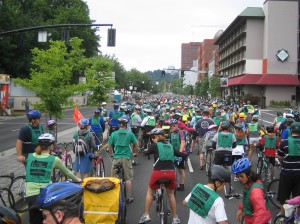It sure is. Bendians (Bendites? Benders? Bendies? Bendos?) People from Bend, Oregon have one more thing to brag about besides skiing, rock climbing, Deschutes brewery, exquisite views of the cascade peaks, high mountain lakes, a lot more sun and a lot less rain than Portland- a great bike path network. We went over for the weekend and the weather was cool, crisp and fragrant with the spicy smell of woodsmoke. Meanwhile on the west side of the mountains the rain fell in dense sheets.
On previous trips I had noted the multitudes of mountain bikes and road bikes alike, all gleefully riding on magnificent paths often separated from the road by a lushly landscaped median. This trip we brought our own city bikes, intent on experiencing the paths for ourselves.
I’m happy, very happy to report we hardly had to ride on a bike pathless or laneless road the entire time. Even the main road right in front of our hotel, which was a mile outside of downtown in the big box store and mini-mall zone had a bike lane. The desk attendant hesitated only a moment when asked how to ride up the Deschutes river, (which I knew you could do at some point for several miles). Although her directions didn’t work out, we still had a lovely time getting lost, and she got points for not staring at us for asking what is, in most small towns in America, a flabbergastingly stupid thing, biking being strictly for children and those too poor or witless to buy a car.
Even in Portland, it’s not uncommon for a fat, luxurious bike lane to suddenly disappear, casting the hapless cyclist into the teeth of his deadly steel neighbors. Naturally it was the same in Bend, but less so than Portland which is one of only three platinum level bicycle friendly communities in the country! Like Portland, bike lanes ended without warning, but invariably once we turned the corner, hurray, there’s another bike lane!
Bend is full of traffic circles. Rich, retired Californian emigres plus tiny cowboy town equals instantaneous and massive town planning, emulating Europe on the scale of the reconstruction of Dresden after WWII. The result is a well thought out master planned town complete with a mall built around an old lumber mill and a river famous for its fly-fishing and world-class rapids meandering through downtown.
City planners didn’t forget bicycles when they put in these alternatives to intersections. As the bike lane approaches the traffic circle, it merges onto the sidewalk and the cyclist proceeds around the circle until choosing their direction, whereupon the path reappears. This kind of thought and, more importantly, expense is awfully impressive and almost unheard of. Combine this infrastructure with the restaurants, parks and brewpubs in town and great riding outside of town and you have bicycle nirvana. Good for you Bend!






You must be logged in to post a comment.